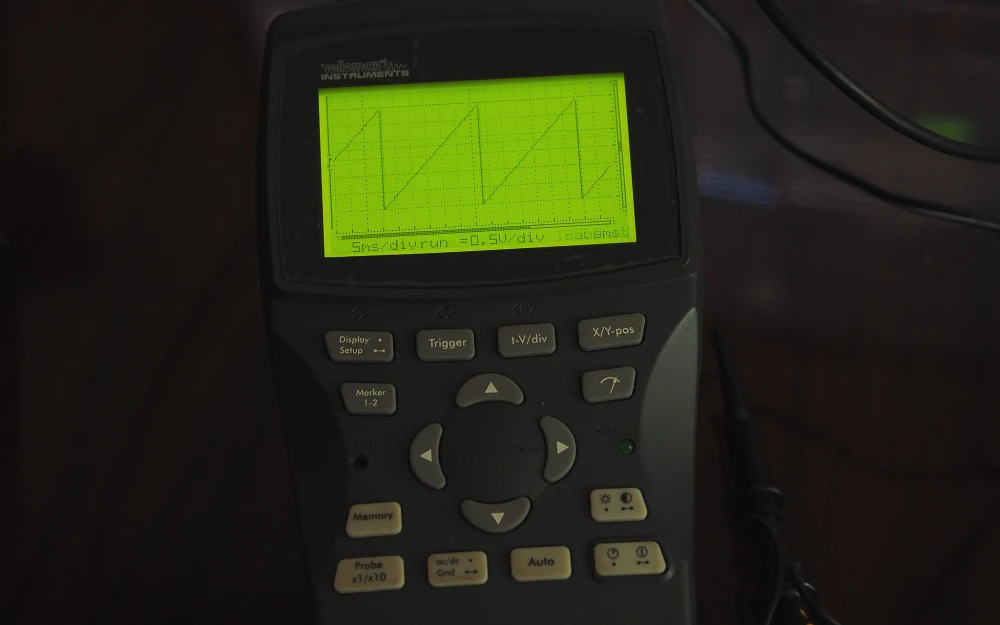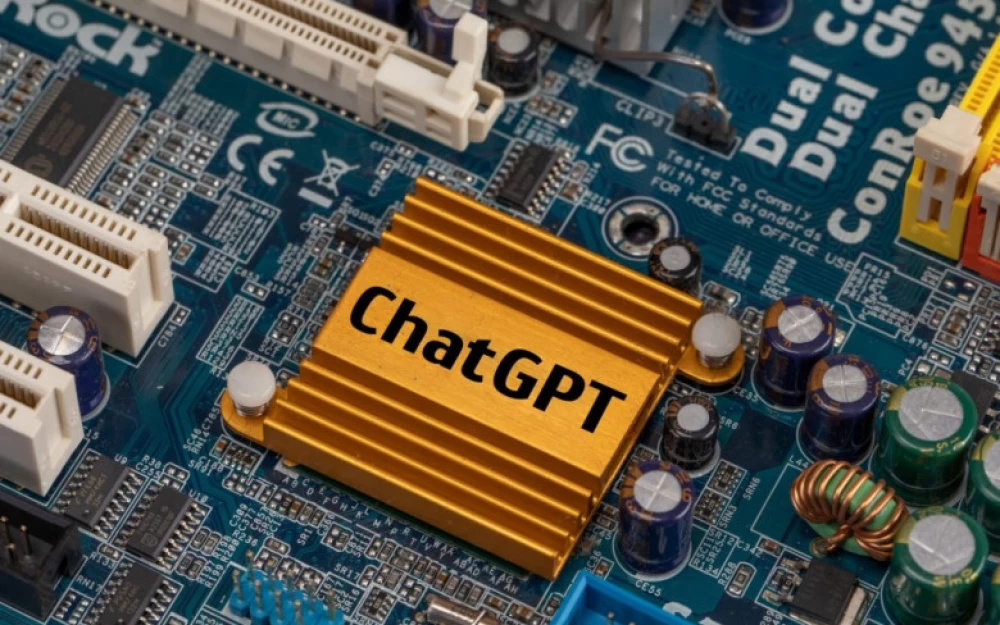- DIY
- A
Velleman HPS40 — compact oscilloscope from 2002
Let me tell you about a vintage Swedish oscilloscope with a monochrome screen and an elegant design of the interface and case. I will discuss its electrical characteristics and show oscillograms of test signals.
▍Specifications
Maximum sampling rate: 40 MSa/s for repetitive signals (10 MSa/s for single events).
Input amplifier bandwidth (-3dB): From 5 MHz at 5 mV/div to 12 MHz at 50 mV, 1 V, and 20 V/div.
Input impedance: 1 MΩ, 20 pF.
Maximum input voltage: 100 V peak (DC+AC), 200 V peak-to-peak (AC only).
Inputs: DC, AC, and GND (GND for automatic offset setting).
Other characteristics
Vertical resolution: 8 bits.
Trigger modes|Normal, Single, Scroll mode for 1 sec/div and slower sweep.
Trigger level: Adjustable in 8 steps.
LCD display: 112×192 pixels with green LED backlight.
Signal storage|256 samples with 2 memory cells, max. 179 visible samples (256 with X-shift).
dBm measurement (0 dBm = 0.775 V at 600 Ω): From -73 dB to +40 dB (up to 60 dB with X10 probe) with an accuracy of ±0.5 dB.
dBV measurement (0 dBV = 1 V): From -75 dB to +38 dB (up to 58 dB with X10 probe) with an accuracy of ±0.5 dB.
True RMS measurement: From 0.1 mV to 80 V (up to 400 V square with X10 probe) with an accuracy of 2.5%.
AC peak-to-peak sensitivity (reference sinewave): From 0.1 mV to 160 V (from 1 mV to 1000 V with X10 probe) with an accuracy of 2%.
Sweep range (32 steps): From 50 ns to 1 hour per division.
Input sensitivity range in 12 steps: From 5 mV to 20 V/div at X1 — from 50 mV to 200 V/div at X10.
Probe calibration output: Approximately 2 kHz / 4.5 V peak-to-peak.
Power supply: 9 V DC / min. 300 mA adapter (non-regulated), 12 V DC with regulated voltage.
Batteries: AA alkaline or rechargeable Ni-Cd, NiMH (requires 5 pcs).
Rechargeable battery charging current: 90 mA.
Battery consumption current (average): On: 170 mA, with backlight: 240 mA, standby current: < 600 μA.
Operating temperature: From 0 to 50°C.
Physical characteristics: Dimensions: 105×220×35 mm, Weight: 450 g without batteries.
▍Appearance and Menu
The oscilloscope is single-channel, and the probe included in the kit is made well. The signal cable is a bit thick, but it’s soft and does not strain the hand during use. The probe handle features a switch for a 10x divider and an adjustment capacitor for compensation.
The case design is reminiscent of the times of monochrome Garmin navigators. It has a restrained style, elegant proportions, and shape. The material is gray matte plastic. The buttons are silicone, with high-quality lettering. Some pictograms and inscriptions are molded on the front panel.
It’s unusual that there is no central OK button in the crosspad, but you quickly get used to it.
Some of the device's functions can be intuitively understood and learned from the labels on the buttons and the hints displayed on the screen. The rest were easily understood from the manual.
The whole set fits into a protective hard case with the company logo. It's smaller than a typical screwdriver case.
The screen displays a signal with a frequency of 4 MHz. The signal shape is already noticeably unstable due to the lack of time resolution.
But a signal around 1 MHz in the form of a square wave can be displayed, although with distorted (sloped) edges.
The oscilloscope can calculate the signal frequency if the user sets the time markers so that the interval between them equals the period of the measured oscillation, and the device will display the signal frequency and period. This is unusual, since in modern devices the frequency of a repetitive signal is calculated automatically.
I’d like to separately note the ability to set a sweep rate of up to 1 hour per division. Thanks to this, the device can be used as a “chart recorder” for slowly changing signals: temperature, pressure, light levels in natural conditions, etc.
The device is equipped with an internal calibrator with an output hidden under the battery compartment cover. It outputs a 2 kHz, 4.5 V square wave.
The device is powered by an external power supply (apparently with a warm iron mains transformer, judging by the weight) or by five AA batteries. NiCd and NiMH rechargeable batteries (5 pieces) can also be used and charged inside the device. But it's better not to leave them inside for too long: even when switched off, the device has noticeable current draw and can discharge the power battery.
The oscilloscope’s software includes functions for measuring tRMS (true root mean square value of voltage), signal level in dBm, dBV, and power level on loads of 2, 4, 8, 16, and 32 Ohms. DC voltage can also be measured.
The device has a monochrome LCD screen, 112×192 pixels, with a green LED backlight. The backlight color is softer than in photos. The waveform refresh rate is acceptable, I expected worse. I noticed that it increases if the mode is used where the screen space is split in half with the “Measurements” field.
Here in the video clip the device is displaying a pulse signal:
Electrically isolated RS-232 port for connection to a PC with proprietary software (which can still be downloaded from the manufacturer’s website).
Here here is a description of the communication protocol.
The service manual describes the process of hardware calibration and adjustment of variable resistors and capacitors on the board. It also contains the complete schematic diagram of the device and a component table.
I will not provide this information, as it is someone else's intellectual property; the documents can be easily found on the internet.
▍Inside
At the input, after the adjustment and limiting circuits, there is a low‑noise, high‑speed operational amplifier OPA2353 with the following specifications:
Rail‑to‑Rail input.
Rail‑to‑Rail output (with an error up to 10 mV).
Bandwidth: 44 MHz.
High slew rate: 22 V/µs.
Low noise level: 5 nV/√Hz.
Low total harmonic distortion + noise: 0.0006%.
Further along the analog signal path, there are miniature relays for selecting the measurement range. After them comes the TLC5510 — an 8‑bit analog‑to‑digital converter (ADC) with a sampling rate of 20 MS/s.
There is also the XC9536XL — a CPLD with a supply voltage of 3.3 V, designed for high‑performance operations with low‑voltage signals. I assume it is used for measurements performed on the signal, including calculating tRMS. It consists of two functional blocks, providing 800 gates with a signal propagation delay of 5 ns from pin to pin. Clock frequency up to 178 MHz.
The oscilloscope’s microcontroller is a PIC18C452. It has 32 KB of EPROM and 1536 bytes of RAM.
▍Impression of use
I especially want to praise the European engineers for the menu organization and the ability to choose what readings to display on the screen.
In pleasant little touches, like the ability to change the type and display of the grid, hides respect for the consumer.
It’s worth mentioning that there’s a function in the menu, disabled by default, for dynamically changing the GUI to make setting triggers easier: the graph display area can automatically stretch to one side of the screen.
Working with the device is enjoyable, menu navigation is intuitive, and over time you learn to operate it without looking at the button labels. When I considered buying it, I was expecting exactly this superior UX compared to Chinese devices, which traditionally have issues with semantics and interface logic.
▍Drawbacks
The power button works strangely. It has a documented function — when pressed and held, it disables the automatic backlight and power‑off mode. But on my device, neither single nor long presses always work. If you connect the device to a power supply, it always turns on. Perhaps this odd behavior is unique to my unit.
The screen contrast is not very high, but you get used to it over time.
Battery drain in standby mode.
My unit is slightly “off” in measurement levels and requires calibration.
▍Conclusions
I really like the device because its capabilities are enough for my experiments, and I enjoy things with a well-developed design and interface. I can confidently recommend this device for beginners, considering its price/quality ratio. Even with a modest oscilloscope, it will be much easier and more interesting to study electronics than without it.
At the time of publication, on a well-known second-hand item selling website, its price ranges from 4500 to 6$0.00.
© 2025 LLC "MT FINANCE"




















Write comment